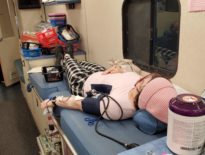
Photo credit: Wikimedia Commons, public domain
[I’m writing this on Sunday, April 5. Everything in this post might be false in a few days, and conditions might be different in places other than Los Angeles. Keep up to date by checking your local health department website.]
“All I maintain is that on this earth there are pestilences and there are victims, and it’s up to us, so far as possible, not to join forces with the pestilences.”
The Plague, Albert Camus
It the last several days the City of Los Angeles, the California Department of Public Health, and the Centers for Disease Control all issued suggestions that all of us wear cloth masks covering the nose and mouth when in public. I have just spent two weeks educating my patients about the previous recommendations that masks don’t prevent healthy people from getting infected, and that there’s no reason for asymptomatic people to wear them. What gives?
Back when I trained, I was taught that surgical masks slowly absorb moisture from the breath and within about 15 minutes they stop acting as a filter since all the pores are closed with water droplets. After that point the mask is simply a barrier that one breathes around, not through, which means that after that point it doesn’t prevent inhaling germs. The surgeon wears the mask so as not to inadvertently cough or spray saliva onto the sterile surgical field, not to protect herself from exhaled germs from the patient. This led me to think that citizens in Asian countries in which mask wearing is common were superstitious germophobes. They clearly didn’t know that the masks were not protecting them and were wearing them as magical amulets to ward off disease.
Many years later colleagues explained to me that pedestrians in Asia are wearing masks to protect other people, not themselves. They use a mask if they must go to work with a cold and wish to avoid infecting their coworkers. They’re using the mask as a barrier, not a filter.
That’s the logic behind the current recommendations. And, it must be said, the science behind them is scant. We know from lots of other respiratory infections that social distancing works. We have known since Dr. Ignaz Semmelweis that hand washing is critical in preventing the spread of infections. The evidence for masks in preventing infection from asymptomatic people is much flimsier, but I’ll lay out the case.
We know that the novel coronavirus can be spread by infected people before they know they’re sick. We know that some people infected with the novel coronavirus never get symptoms, and even those who get symptoms are infectious for a few days before symptom onset. So social distancing is a mechanism predicated on the assumption that we all might have it and intended to prevent us from infecting one another.
We also know that the amount of virus that a person is infected with makes a big difference to the severity of their disease. Meaning, if you inhale a tiny amount of virus your immune system might clear the virus without any symptoms, but if you inhale a high number of virus particles, the virus will have a head start, and will have a chance to replicate and cause illness before your immune system can catch up.
So masks are a tiny intervention for a very specific situation. They are just a way to reduce the number of virus particles that someone who is infected and doesn’t know it exhales on other people. This should only be relevant in the few instances when social distancing breaks down – a customer at a grocery store approaching the cashier, pedestrians on a sidewalk failing to avoid each other, neighbors in an apartment building passing in a stairwell or taking the same elevator. Masks are just a way to make those encounters a tiny bit less risky for the other guy, not for the mask wearer.
And masks have the additional benefit of reminding us not to touch our face, which might result in a germy respiratory droplet being transferred to our hand, and then to that doorknob, and then to someone else’s hand.
Of course, surgical masks are in short supply and should be preferentially saved for healthcare workers, so cloth masks (or scarves or bandanas) are recommended.
The critical caveat is that wearing a mask should be done in addition to, not instead of, frequent hand washing and social distancing. Public health officials are stressing that hand washing and social distancing are proven effective measures, and that mask wearing would yield a net harm if people thought that masks made the other measures unnecessary.
I was left with the impression that recommending masks was a minor intervention backed by weak studies which at best would have modest effects. Why bother?
Well, Californians have been told to socially distance for just over two weeks. That’s long enough that if new infections were stopped by these measures, we would have seen it reflected in a decrease in the number of new cases. Instead, on Saturday Los Angeles County reported the largest number of new cases so far, 711. That doesn’t mean that social distancing isn’t working. The number of new cases would be far worse without it. It simply means that, like any activity attempted by 10 million people, we’re not doing it perfectly. There are clearly still enough interactions between people that are allowing this incredibly infectious pathogen to find new hosts.
So, it’s time for all of us to improve our performance of social distancing and hand washing. And there’s never been a better time to add on a minor intervention backed by weak studies which at best would have modest effects. If ten million of us do it, as feeble as it is, we might protect the next 711 people who would have been infected tomorrow. We need that number, day by day, to get closer to zero.
It is frightening to find ourselves in a time of plagues. And this horrible pox has not yet dealt us its worst. But we are also in a time of masked heroes whose superpowers are hand washing and social distancing. And they also put on a mask, mostly to let us know they will not join forces with the virus.
Stay inside and stay healthy.
Learn more:
U.S. Expected to Recommend Cloth Face Masks for Americans in Coronavirus Hot Spots (Wall Street Journal)
These Coronavirus Exposures Might Be the Most Dangerous (New York Times)
What Are the Benefits of Wearing a Face Mask? (Wall Street Journal)
Face Coverings Guidance (California Department of Public Health)
Guidance on wearing face coverings in public (City of Los Angeles)
Guidance for Cloth Face Coverings (Los Angeles County Dept of Public Health)
Use of Cloth Face Coverings to Help Slow the Spread of COVID-19 (Centers for Disease Control and Prevention)
My previous posts about the novel coronavirus:
Updates From The Socially Distant
Testing, Testing
Novel Coronavirus FAQ Part 2 – Pandemic Hullabaloo
Coronavirus Frequently Asked Questions
Community Transmission Of Novel Coronavirus In LA County
What You Need To Know About The Novel Coronavirus

